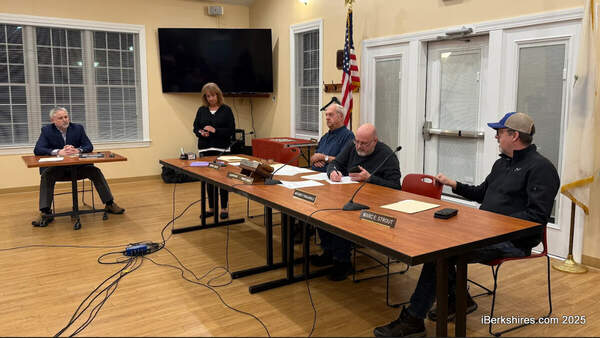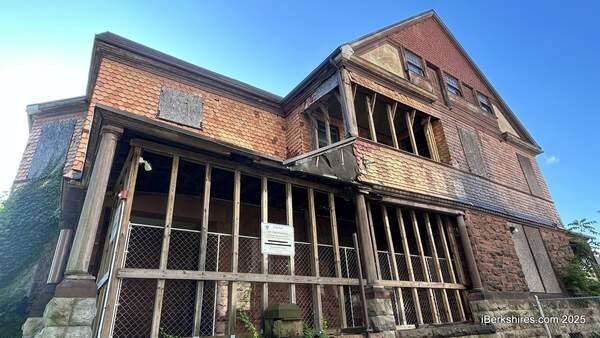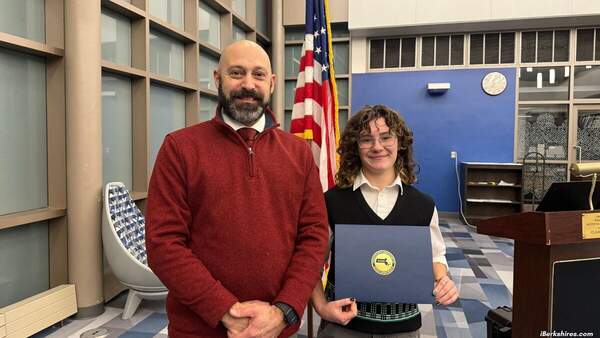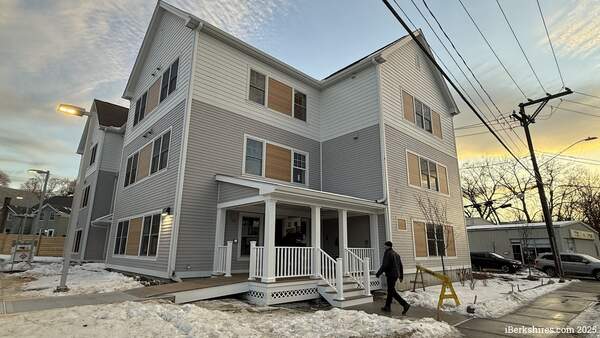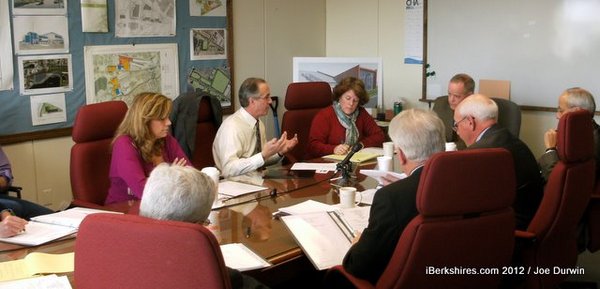
PEDA Hears Concerns From Mayor, Community Members
PITTSFIELD, Mass. — The Pittsfield Economic Development Authority faced its most extensive series of questions yet on Friday about plans to build a new retail complex on a large portion of the William Stanley Business Park.PEDA's first meeting of the new year at the park was unusually well attended, featuring a lively, unscheduled discussion on the recently announced Waterstone Retail Development proposal with Mayor Daniel Bianchi and members of the public.
Executive Director Corydon Thurston said there was "nothing new to report" in his monthly update to the board other than that lease negotiations have begun and that Waterstone is creating a presentation for the city as preparation for the permitting process. The main discussion over this issue took place as the board prepared to adjourn its meeting, at which time Bianchi, attending his first PEDA meeting as mayor, suggested taking the time for some further discussion.
"I think a lot of people are very interested in the Waterstone Development issue, and I know that you guys have talked about this in other meetings, but looking at a lot of the minutes it's really hard to get a grasp of how that came about, and the timing on it," said Bianchi. "I think the public has been concerned since it's been announced, the significant change in the direction of the board, to go in that direction as opposed to the original mission of sticking with attempting to build a park with different types of industrial projects.
"I think a greater public discussion is needed and/or was needed," Bianchi told the board.
Board members and Thurston repeatedly emphasized that the process of public input has not been bypassed, but is just begining.
"We have land that there is a letter of intent [from Waterstone]," said Chairman Gary Grunin. "The board, and the public, and the city and you as mayor have not seen a plan because there is no plan yet. The developer is working on a plan, which he will bring to the city."
The proposal will then have to go through the Community Development board, and get approval of various department heads, before eventually reaching the City Council.
"So the letter of intent doesn't bind you to anything, it doesn't bind you to this approach?" Bianchi asked to clarify.
Thurston said this is one of the reasons why there has been no word on who the tenants of Waterstone's development might be. "The tenants won't sign with the developer until the permits are in place for the buildings, the developers aren't going to commit to a formal lease with us, until permits are in place."
Over the next 20 minutes, as well as during an hourlong informal discussion after the meeting, the board answered questions posed by the mayor and others, including Michael Ward, former Ward 4 who has begun a petition against the project. These included some of the key concerns raised by residents in the wake of the Waterstone announcement
PEDA officials said their current goal was to create a mixed-use property, which would ideally combine retail, industrial, research and development and other commercial operations.
"If you look at other urban developments throughout the country, more and more are going for mixed use," said Grunin. "More and more R&D facilities, and light manufacturing businesses, like to be in a business park that has retail within it."
Bianci said that in his previous job [at Global Partners LP], he had worked with a lot of industrial parks, "and I haven't necessarily seen that, but maybe that's a trend that I've been missing."
"What percentage of the park is going to be encumbered by this?" the mayor asked.
The proposed development, he was told, would take up to 16 of the park's 52 acres.
"We'd still have 40 percent of the park," Grunin said, after that taken up by the solar array, the Mountain One building, Action Ambulance and the proposed retail area.
In addition to the PEDA site, Grunin said there were still "hundreds of acres" of other available land for industrial development in Pittsfield, should they attract a business looking for some, much of it without the prohibitive cost of development that this parcel will require.
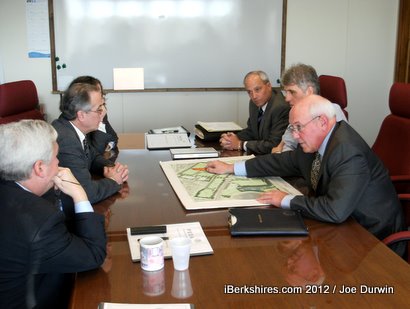 The board spent another hour with Bianchi and residents after the formal meeting discussing a proposed retail development at the business park. |
Regarding what some critics have called a lack of transparency, Bianchi said, "I think it maybe it would be helpful for the public if they had a little better understanding of what your marketing efforts have been to date, and your efforts to source manufacturing, or some of the industries we've talked about."
Board member George Whaling suggested it might be helpful for the PEDA board to buy advertising space "and just lay out the facts. What we know, what we don't know, and what the process is. There may be the sense that this is behind closed doors, that this is a clandestine operation, and that's not the case at all."
In a general response to one of the points raised by some opposed to the development, Whaling told the mayor, "From my perspective, a lot of my good customers are retail tenants. If you think that I would put them in a situation that would hinder or cannabalize their business, absolutely not. I truly think that if this situation does come to fruition, it's going to be good for the city, it's going to be good for the park.
While it may not be anyone's ideal, Whaling added, "We are not in a position to land a 200-employee manufacturer into the heart of the city."
Thurston said the new development could mean up to another half-million dollars in tax revenue for the city, based on "existing examples of BJs and others."
"If you look at the definition of economic development, and what we're trying to do, when we have an interested fish on the hook, we're going to talk to them and do our best reel them in," he said. "We also, at the same time, are going to do that in a manner in which, it's what the city wants. It's not competing. It's such an early stage in the process."
After the meeting adjourned, PEDA board members stayed to discuss the specific parcel in question in much greater detail with the mayor and Ward, with a couple of concerned residents staying on to listen. The conversation touched on key points of ongoing public interest, such as the nature of redevelopment needs there, rail access, and the ever crucial issue of PCB pollution.
Board members pointed out that the restricted uses listed in the DEDA, which include retail and food businesses, were not necessarily a planning imperative, but were required by GE in order to limit the company's liability at a time when the site hadn't undergone any cleanup and because retail would have required different cleanup standards.
"It's cleaner than originally anticipated," said board member Maurice Callahan, this being cited as the reason GE has signed a waiver allowing the Waterstone development.
"Back in '98, when it was created, there were concerns about the liability, and no one knew," said Thurston, "so they said 'let's take all the areas where that might be an issue, and make that restricted.'"
Another key issue covered was the possibility of rail access at the proposed retail location. Bianchi asked if by building the proposed retail facility there, "would we jeopardize future options for a larger facility that really needs the rail?"
While another, smaller 9,000-square-foot parcel with ready-made rail access has already been reserved for this purpose, Bianchi suggested that was "limited."
"There's just not that many rail facilities of this configuration up here in our area. I just want to make sure we don't make any moves that would knock possibilities off the table," said the mayor.
The board further discussed the cost of readying that parcel for construction, which was suggested could be from $1 million to several million, including connection of utility lines, was something that Waterstone was already clearly aware of and willing to confront but which the board feared many industrial prospects would find unappealing.
Ward wanted to know how PEDA's overall planning process aligned with the city and its own master plan.
"Everything we do here the Community Development Office is aware of, before we do it," Thurston said. "I call them all the time. They're the professionals."
Nonetheless, Bianchi pushed for a greater reporting from the agency on things like specifically how many commercial prospects they've had, how many didn't work out and for what reasons. He suggested that if the public was made aware of what PEDA's marketing efforts have been, "It might help support the 180-degree turn."
Despite vigorous questioning and several moments of polite disagreement, the overall tone of both meetings was congenial and friendly.
The mayor is expected to put his nomination to the PEDA board before the City Council later this month. If approved, which sources on the council say is probable, he will replace Peter Fruet, whom James Ruberto appointed to replace him on the board in the final months of his mayoral tenure.
Tags: business park, PEDA, retail,

